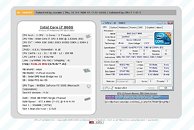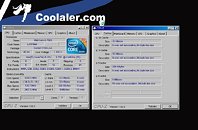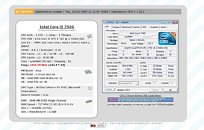Tuesday, October 20th 2009

Energy-Efficient Intel Core i5, Core i7 ''Lynnfield'' Processors Overclocked
In the run up for Intel's Core i5 and Core i7 "Lynnfield" socket LGA-1156 processors, it was known that Intel will be trailing the launch with a few energy-efficient variants, that come with lower rated TDPs. Two of these, namely Core i5 750S, and Core i7 860S have made it to Coolaler's lab for a quick check up. Unlike other energy-efficient variants from Intel, in the past, such as Core 2 Quad Q9550S, these parts feature lower clock-speeds compared to their standard counterparts.
The Core i5 750S comes with a clock speed of 2.40 GHz (19.0 x 133 MHz) with a Turbo Boost speed of 3.20 GHz, and the Core i7 860S runs at 2.53 GHz, with 3.46 GHz of Turbo Boost speed. Both processors as a result, have lower TDPs of 82W, compared to 95W on the Core i5 and Core i7 "Lynnfield" processors currently in the market. They are slated for Q1 2010. Coolaler used the Turbo Boost mode to overclock these chips. The Core i7 860S with its Turbo Boost multiplier of 26.0, reached 4.536 GHz (26 x 174.47 MHz, vCore at 1.32V), while the Core i5 750S reached 3.441 GHz (24 x 143.4 MHz, vCore at 1.32V). Both were seated on an ASUS P7P55D Deluxe motherboard, with one 2 GB DDR3 memory module.
Source:
Coolaler
The Core i5 750S comes with a clock speed of 2.40 GHz (19.0 x 133 MHz) with a Turbo Boost speed of 3.20 GHz, and the Core i7 860S runs at 2.53 GHz, with 3.46 GHz of Turbo Boost speed. Both processors as a result, have lower TDPs of 82W, compared to 95W on the Core i5 and Core i7 "Lynnfield" processors currently in the market. They are slated for Q1 2010. Coolaler used the Turbo Boost mode to overclock these chips. The Core i7 860S with its Turbo Boost multiplier of 26.0, reached 4.536 GHz (26 x 174.47 MHz, vCore at 1.32V), while the Core i5 750S reached 3.441 GHz (24 x 143.4 MHz, vCore at 1.32V). Both were seated on an ASUS P7P55D Deluxe motherboard, with one 2 GB DDR3 memory module.




17 Comments on Energy-Efficient Intel Core i5, Core i7 ''Lynnfield'' Processors Overclocked
Is there some technical reason why they'd want to do that?
Bring on the 45W i7s!
Think of a game... throw in a little physx... and oohps... the thing just choked.
OK, so this setup will get some great superpi scores, but will be pretty poor on cinebench, geekbench, fritz, etc.
Lets see some actual BENCHMARKS proving any form of reasonable stability ?
Coolaler was able to OC the CPU's to a very high clock WHEN IDLE! Big freaking deal.
When that CPU is doing some heavy crunching (on single thread) the turbo multiplier will cut down due to how thermal management works on the CPU. With good cooling, you might just be able to maintain that overclock. However, Coolaler didnt show such figures, and we can therefore only presume his superpi run wasnt stable, OR, the turbo cut back giving not so amazing figures.
But more, IF that CPU is running a multithread crunch, the turbo will cut back a lot more.
And that just IS how turbo mode works. Post #6. Read and repeat. For all your OC'ing effort, throw in some serious multitasking and you will be BACK AT NEAR STOCK performance.
Do you know the exact mechanisms for how the [turbo+thermal managment] feature works? Is there a complex lookup table which basically manages the turbo multiplier based on core utilisation (backend and frontend instruction pipe)? Or is it fully "live and dynamic" thermally managed? Or a mix of both?
What happens when a stable idle OC (like above) gets attacked with some heavy crunch number? Will the turbo+thermal management cut back to maintain stability, and to what level, or will the CPU operate beyond the planned TDP and possibly fail? Curious.
I would imagine the processor's on-the-fly Turbo Mode management to be similar to that of the Intel SpeedStep (EIST), where the processor adjusts itself instantly depending on the load. Control over the processor's power states are given to local firmware.
Conversely a stable multithread OC may not be stable when flying on an even high multiplier single thread.
It's a double balancing act... and it probably why we dont see coolaler showing any successful benchmarks at those speeds.
Will be interesting to see what the OC community can pull